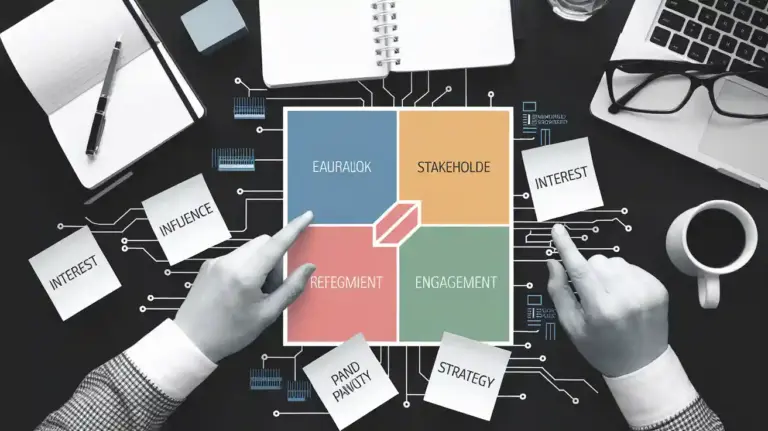Are you a change management professional looking to improve your communication planning? Effective communication is crucial for the success of any change initiative. Without clear and consistent communication, stakeholders may become confused, resistant, or disengaged.
As a change management professional, it is your responsibility to develop and implement a communication plan that addresses the needs of your stakeholders and supports the goals of the change initiative.
In this article, you will gain insights into change communication planning that will help you improve your effectiveness as a change management professional. You will learn about the importance of effective communication in change management, how to understand your stakeholders, how to develop a communication strategy, how to identify and overcome communication barriers, and how to evaluate and improve your change communication plan.
By following these guidelines, you can build a robust communication plan that will help you achieve your change management goals and engage your stakeholders in the process.
The Importance of Effective Communication in Change Management
When things are changing, getting everyone on the same page and in the loop can make all the difference. This is especially true when it comes to change management. To successfully navigate through change, effective communication is key.
It’s not enough to simply announce changes and hope everyone falls in line. You need to actively engage your employees and communicate with them through various channels. Communication channels are an important aspect of change communication planning. You need to choose the right channels to get your message across to your employees.
This could be through company-wide meetings, emails, or even social media. The key is to choose channels that are accessible to all employees and that will reach them in a timely manner. By using multiple channels, you can ensure that your message is heard and understood by everyone.
Employee engagement is also crucial in change management. You need to keep your employees informed and engaged throughout the process. This means involving them in discussions and soliciting their feedback. By doing so, you can address any concerns or issues that may arise and ensure that everyone is on board with the changes.
When employees feel included and valued, they’re more likely to embrace change and work towards a successful outcome.
Understanding Your Stakeholders
As you explore the dynamics of those who have a vested interest in your project, you’ll be better equipped to anticipate their reactions and adjust your approach accordingly. This is where stakeholder mapping comes in.
Stakeholder mapping is a tool that helps you identify the different groups of people who will be affected by your project. By doing so, you can better understand their needs and concerns, and create a communication plan that addresses those issues.
Once you’ve identified your stakeholders, it’s important to determine the best way to communicate with them. This is where communication channels come in.
Communication channels refer to the different methods you can use to convey your message to your stakeholders. For example, you may choose to communicate with your stakeholders through email, social media, or in-person meetings. It’s important to choose the right communication channel for each group of stakeholders, as this can greatly impact the effectiveness of your message.
Overall, understanding your stakeholders is key to effective change communication planning. By using stakeholder mapping and selecting the right communication channels, you can ensure that your message is received and understood by those who are affected by your project. This will not only help you achieve your goals, but also build trust and goodwill with your stakeholders.
Developing Your Communication Strategy
You’re on the path to crafting a communication strategy that’ll captivate your stakeholders and ensure they understand your project’s goals and objectives.
The key to developing a successful communication plan is to craft messages that resonate with your audience. Start by identifying the specific points you want to convey, and then tailor your approach to each stakeholder group.
Crafting messages involves distilling complex information into bite-sized pieces that your stakeholders can easily absorb. Avoid using jargon or technical terms that may be unfamiliar to your audience. Instead, use plain language and concrete examples to illustrate your main points.
When selecting channels, consider the preferences of your stakeholders. For example, some may prefer email updates, while others may prefer face-to-face meetings.
Tailoring your approach to each stakeholder group is essential for effective communication. Audience segmentation involves dividing your stakeholders into groups based on their interests, needs, and preferences. This helps you to identify the most effective channels and messages for each group.
By tailoring your approach, you can ensure that your stakeholders are engaged and invested in your project’s success. Keep in mind that communication is an ongoing process, so be prepared to adjust your strategy as needed to ensure that your stakeholders remain engaged and informed.
Identifying and Overcoming Communication Barriers
If you’re struggling to get your message across and engage your stakeholders, it’s time to identify and overcome the communication barriers standing in your way. Common barriers include resistance to change, lack of trust, and inadequate communication channels.
To overcome these barriers, consider the following practical solutions:
- Address resistance to change by communicating the benefits of the change and involving stakeholders in the process.
- Build trust by being transparent and authentic in your communication and actions.
- Improve communication channels by using a variety of methods, such as face-to-face meetings, email updates, and online collaboration tools.
In addition to these common barriers, cultural considerations and language barriers can also hinder effective communication. When working with stakeholders from different cultures, it’s important to be aware of cultural differences and adjust your communication style accordingly.
This may include using more formal language, avoiding certain topics, or using nonverbal communication cues that are appropriate to the culture. Language barriers can also be addressed by providing translations or interpreters, or by using simple and clear language that’s easy to understand.
By identifying and overcoming communication barriers, you can improve your change communication planning and increase stakeholder engagement. Remember to be flexible and adaptable in your approach, and to prioritize clear and effective communication throughout the change management process.
Evaluating and Improving Your Change Communication Plan
Evaluating and improving your change communication plan can be achieved through a detailed analysis of the effectiveness of your strategies and implementing necessary adjustments to ensure successful stakeholder engagement. Measuring effectiveness is crucial in determining how well your communication plan is working. This requires setting specific metrics and regularly assessing whether you are meeting them. For instance, you can track the number of emails or newsletters that are opened or the number of people attending your virtual meetings.
Iterative improvements are essential in ensuring that your communication plan is always effective. It is important to seek feedback from stakeholders and use it to make necessary adjustments. This means being open to constructive criticism and making changes where necessary. You can also conduct surveys to gather feedback and insights from stakeholders. This will help you to identify areas that need improvement and make necessary changes to your communication plan.
Incorporating feedback and making iterative improvements to your communication plan will help you to achieve successful stakeholder engagement. Remember to regularly assess the effectiveness of your strategies and adjust them where necessary. By doing this, you can ensure that your communication plan is always effective and that you are meeting the needs of your stakeholders.
How can Change Communication Planning Insights be Applied to Creating a Change Communication Plan?
When creating a change communication plan, it’s essential to apply change communication plan strategies. Utilizing insights from change communication planning can help identify key stakeholders, tailor messaging, and determine the most effective communication channels. By incorporating these strategies, a comprehensive and targeted change communication plan can be developed.
Conclusion
Congratulations! You’ve successfully learned about change communication planning and gained valuable insights to help you become a more effective change management professional.
By now, you understand that communication is the backbone of any successful change effort, and that effective communication planning is essential for achieving your desired outcomes.
But don’t just take our word for it. Investigate the truth of this theory yourself. Talk to your colleagues and stakeholders, and ask them about their experiences with change communication.
Keep learning and improving your skills, because in today’s rapidly changing world, effective communication is more important than ever before.
Remember, change is never easy, but with the right communication strategy in place, you can help make the transition as smooth and successful as possible. So take what you’ve learned here and apply it to your next change initiative, and watch as your organization transforms and grows.
Good luck!





